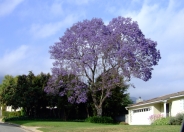
Common name: Jacaranda
Botanical name: Jacaranda mimosifolia
This irregular to rounded deciduous tree will reach about 40' tall and has fine, compound green leaves with blue flowers. Jacaranda's main blooming season is in spring and summer, but it will often produce sporadic blooms in fall as well.
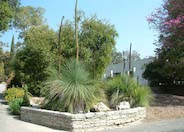
Common name: Australian Grass Tree
Botanical name: Xanthorrhoea quadrangulata
This unusual looking succulent slowly forms a thick upright trunk, reaching 6' tall. At the top of the trunk is long slender grass-like leaves, cascading down like water from a fountain. Foliage can reach 3'-5' tall and 3' wide. Once in a blue moon, white flowers appear above the foliage in spring with lots of nectar. Australian Grass Tree needs full sun, well draining, sandy, dry soil. It is drought tolerant once it's established.
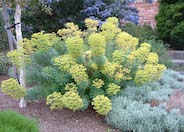
Common name: Bush or Dome Euphorbia
Botanical name: Euphorbia characias
This perennial will reach about 4' tall and wide with a rounded shape. It has blue green leaves with lime green flowers (actually bracts) that bloom from late winter to early spring. When bracts turn yellow, it's time to prune them. Make sure you wear gloves when pruning as plant exudes sap that could cause allergic reaction. This plant does well in full sun and is drought tolerant once it's established. It does spread through saplings but it can easily be controlled.
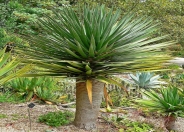
Common name: Dragon Tree
Botanical name: Dracaena draco
This evergreen succulent-looking tree slowly grows to is similar to a palm tree and will grow 25' tall and wide. End of branches have large, sword shaped, blue green leaves which can by 2' long and 1.5' wide! This unusual looking tree produces clusters of green white flowers on the end of the branches during summer, followed by orange berries. However, it may take 10 years before blooms appear. Trunk is gray, single and smooth, with multi-stemmed branches. This tree does best in full sun with well draining, fertile soil. When established, it is drought tolerant. This plant also grows indoors, with strong indirect light. It can reach 3' tall. Interesting note: if the bark is bruised or cut, it may "bleed" a reddish resin which can be used to stain wood. This resin is called "Dragon's blood".
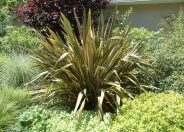
Common name: New Zealand Flax
Botanical name: Phormium tenax
New Zealand Flax is a large, bold plant with stiffly vertical, sword-like, green leaves that arise from its base. It should be grown under full sun for best color. Varieties will offer different growth habits and leaf color.
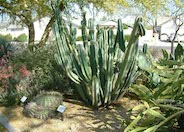
Common name: Hedge Cactus
Botanical name: Cereus hildmannianus
Cereus hildmannianus is an imposing plant with many dull green to bluish-green branches, reaching a height of 30 feet (9 m) or more. The stems usually have 5 or 6 ribs and a diameter of about 6 inches (15 cm), with slight constrictions which mark the end of one year's growth and the start of the next. Older plants usually have a short woody trunk below the lowest branches, but sometimes this is lacking. The spines are variable, with most plants in cultivation having very short spines, while some forms have longer ones.
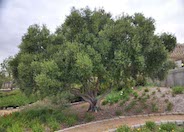
Common name: Olive
Botanical name: Olea europaea
This broad tree will slowly grow to 20'-30' tall and wide. It has small, grey-green, evergreen leaves. Small white fragrant flowers bloom in spring, followed by fleshy black fruit that appears in fall. Fruit is messy and can stain sidewalks. There are cultivars that do not produce fruit. Some folks are allergic to the blooms. This tree is very long lived, with a beautiful gnarled trunk. It prefers full sun and low watering in summer months (twice a month) and none during the winter, when established.